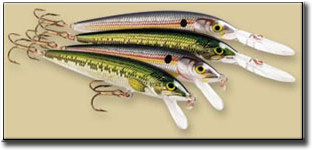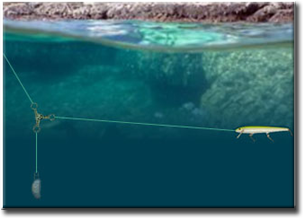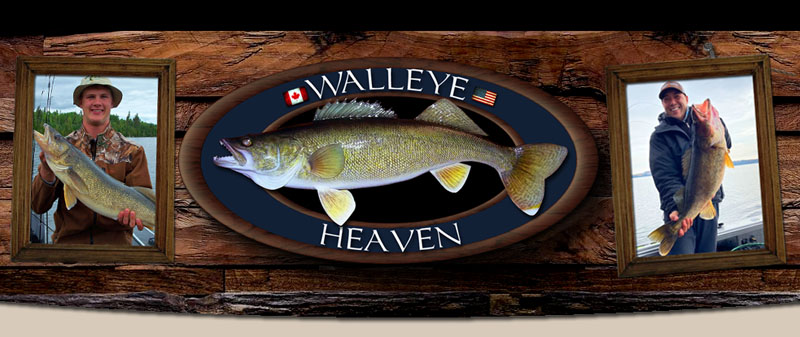Deep Water Rigs for Walleye
When you catch a big Walleye, big meaning over 6-pounds, there is a 95% chance that it's a female. The big females generally only come shallow in the spring when they are up along the shore, in rivers or over sandbars, which are their favorite places to spawn. The smaller males seem to stay in the 2 to 15 foot range all year. The bigger females tent to go deeper then 15 feet. When fishing deep for big mid-summer Walleyes, I like to fish between 25 and 40 feet deep.
Why do the big females go deep? There are several explanations depending on the size of the lake and how far north the lake is.
1) Bigger females have a larger air bladder, which makes them hyper sensitive to changes in atmospheric pressure. Being deeper makes the adjustment a little easier when the weather changes.
2) Bigger females spend too much energy chasing small baitfish that are found in shallow water. The bigger baitfish that are found is shallow water like Perch, Bluegill, Crappy etc… are hard to swallow as they have defensive spins in their fins. Lake Chub, Whitefish, Lake Chad and Cisco are all found in abundance down deep. They are easier to swallow and more rewarding when considering the amount of energy needed to catch them. These deepwater baitfish, especially Whitefish, have more oil in their meat thus more calories.
3) A Walleyes metabolism speeds up in shallow warm water. As a result, the bigger they get, the more food they need to maintain their weight. If the food is not there, they go to deeper cold water so their metabolism slows down. The dangerous thing about being a fish is there is a fine threshold between eating more or conserving energy. If a big Walleye gets to the point where they can not find enough food to maintain their weight, they do not get smaller, they die. As soon as a Walleye gets to the point where they are starting to weaken from lack of food energy, they do not have the energy to catch baitfish and starve to death.
4) In smaller northern lakes, there is a larger population of Pike. Pike regularly attack Walleyes and bigger slower moving females are an easy target. This is another reason why they go deep right after they spawn.
 Big Lakes:
Big Lakes:
When you are Walleye fishing on big water, the Walleyes tend to stay suspended along with the schools of baitfish. Lets say you were on a big lake Like Lake Nipssing or Cedar Lake in Northern Ontario. The best thing to do is troll until you come across a deeper school of baitfish and then keep trolling over the bait school.
These schools of bait-fish can be 15 to 40 feet deep and the Walleyes will be there to. The most popular lures are the Rapala Husky Jerks and the Rattlin' Fat Raps.
--> 10 to 20 feet deep - Regular Husky Jerks
--> 20 to 40 feet deep - Down Deep Husky Jerk or Down Deep Rattlin' Fat Rap
Just troll around and use your depth finder to spot schools of fish. To determine how deep you are, the Regular Husky Jerks go down about 1 foot for every 10 feet of line out. The Down Deep Rapalas go down about 3 feet for every 10 feet of line out. So using a Down Deep Rapala, getting down 30 feet deep means you need 100 feet of line out. This is just a general estimate. The speed of your troll will effect how deep the lures will go.
3-Way Swivel Rig:
The best way to fish down deep for Lake Trout is with 6-pound test line and a 3-way swivel rig. This technique is also excellent for Walleyes that are right on bottom in the 20 to 60-feet of water.
 You need 6-pound test because thicker line has too much friction with the water and it will be hard to find the bottom. You also need a 1-oz or 2-oz weight, a 3-way swivel and a lure that does not sink. I like to use an Original floating Rapala, Junior Thunderstick, Countdown Rapala or a worm harness (crawler harness) with small spinner blades and a big fat worm..
You need 6-pound test because thicker line has too much friction with the water and it will be hard to find the bottom. You also need a 1-oz or 2-oz weight, a 3-way swivel and a lure that does not sink. I like to use an Original floating Rapala, Junior Thunderstick, Countdown Rapala or a worm harness (crawler harness) with small spinner blades and a big fat worm..
With Walleyes, the rig is similar to a trout rig but the line ratios are different. You need a 3-foot lead line from the 3-way swivel to the sinker. Then you need a 5 or 6-foot lead line to your lure.
Get a strait slow troll going and slowly let out line until your sinker hits the bottom. Then real up a foot and wait.
Personally, I like to troll down around 30 feet deep with a small-bladed worm harness and a big fat worm. You can also use de-scaled strips of Walleye or Perch belly meat or Walleye Gullet on the harness as well. I have heard from some people that Chicken Liver works really well. When I find an area that seems to be producing Walleyes for a while and then they stop hitting; I will stop the boat and just drift with a salted minnow on a normal size hook and a tiny weight. I just let the minnow drop to the bottom and drag it and giving it little jerks once in a while to clean it off and give it some action. This is actually how I caught my very biggest Smallmouth Bass, which was just a hair under 7 pounds. I thought I had a 20 pound walleye on and almost shit my pants.
Check out my Bottom Bouncing Walleye Rigs
For a more detailed description of the 3-way swivel rig, please view my Deep Water Trout Techniques.

